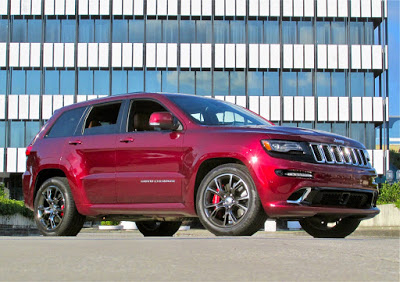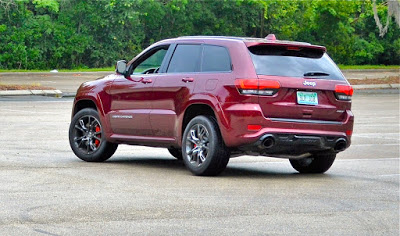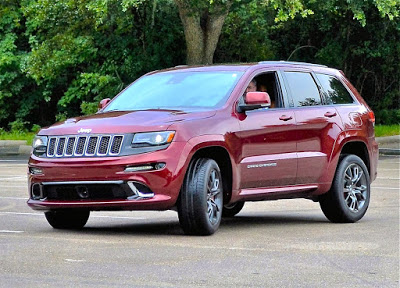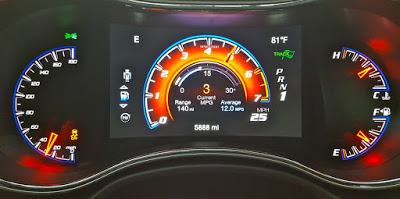Birthed by the Street and Racing Technology team responsible for the V-10 Dodge Viper as well as the Charger and Challenger SRT392s and Hellcats, this hunkered-down Grand Cherokee commands respect both on and off road.
“Regular” Grand Cherokees make do with a 3.6-liter V-6, a 3-liter EcoDiesel or a 5.7-liter V-8. But our 5,600-mile-old Grand Cherokee SRT has a 6.4-liter HEMI with aluminum alloy heads. It funnels its 475 horsepower and 470 pound-feet of torque through an 8-speed automatic hooked to a traditional shifter, as well as paddle shifter.
This Jeep has four-wheel-drive. But it’s a full-time Quadra-Trac 4×4 system with a big mechanical “wet” clutch and electronic limited slip differential in the rear that allows up to 100 percent of torque sent to one rear wheel if needed. Torque split and suspension damping is handled with a new Selec-Trac center console knob. Our 5,104-pound SUV had Auto, Sport, Tow, Track, and Snow modes, which control all-wheel drive, transmission, paddle shifters, stability control, suspension and steering.
Auto is the default and launches quick off the line when your right foot demands, with torque split 40 percent front, 60 percent rear. Eco lets the engine shift into 4-cylinder on highway and deceleration to save gas, with second gear starts.
The most daily fun was Sport, which increased throttle response, let the 8-speed shift quicker and blip throttle on downshifts, and nicely firmed up steering and suspension. It adjusts four-wheel-drive torque split to 35 percent front axle/65 percent rear for more cornering fun. Sport also let me hold a gear when I used the paddle shifters.
We netted 0-60 times of 5 seconds and 0-100 in 12.9 seconds in this mode, the four-wheel-drive putting the power to all four Pirellis as they dug in, the 8-speed shifting precisely and quickly.
Like all SRT vehicles, the main navigation screen also has a multi-page Performance Control display that shows speed and braking, engine gauges and acceleration, braking G force and steering angle. You can set launch control rpm between 1,500 and 3,500 in 250 rpm increments for drag strip launches. You can trigger a shift light that makes the digital tach display glow red as you hit that rpm. Custom lets me mix settings. The system records all Launch Control runs in eighth- and quarter-mile as well as 0-60 and 0-100 mph.
Track mode delivers all 475 horses immediately with quicker shifts, sets suspension to full firm and dials in a 30 percent front/70 percent rear torque split. This is where we used Launch Control, also available in Auto and Sport. That adjusts suspension, stability control, driveline, and transmission settings to get the best hole-shot off the line. Tap Launch Control next to the Drive Mode, then hold the brake as you floor the gas. When the gauge display flashes go, meaning the rpm is where you set it, release the brake and the SRT handles the torque split as traction control turns off. We netted 4.8 seconds to 60 and 12.8 seconds to 100 mph in launch control after setting it to 3,250-rpm. The engine bellowed as shifts came hard and clean with an exhaust “whoomp!” – gas mileage dipped below our average 13-mph.
This SRT rides on a short- and long-arm (SLA) independent front suspension with aluminum upper- and lower-control arms. In back, a multi-link design with aluminum lower control arm. Bilstein adaptive damping is front and rear. On Auto, the ride was plush and under control, quickly buffered rebound on bumps. Sport really tightened up the heavy SUV’s suspension without rattling teeth, speed bumps negotiated at speed with a firm rebound without shock. Track made the ride almost choppy over bad roads, but there was still some buffering at full rebound, but really tightened up the steering nicely.
With the four-wheel-drive biased 65 percent aft in Sport, the Grand Cherokee SRT cornered very nicely, with a slice of understeer and some body roll. Sure, you felt its size, but it was quite happy to play in the curves. The only time we felt like we were playing in an SUV was if we hit a bump in mid-turn and its cornering line was upset. Set in Track mode, with 70 percent torque to the rear and stability control off, it felt like a tall Challenger.
The Grand Cherokee SRT became fun in corners, with the ability to let the rear end play as we powered out. The Pirellis really gripped, the big SUV well mannered. The electric power steering was direct and offered decent feedback in Normal, then got some real steering feel in Sport. And with 15-inch slotted front disc with Brembo six-piston calipers, and 13-inch slotted rear discs with Brembo four-piston calipers, pedal action was short and sweet with great control and no fade.
The Grand Cherokee SRT may be the subtlest looking member of the FCA performance family, but it still exudes attitude behind the classic seven-slot Jeep grille and squared-off wheel arches. The most apparent is the 1.5-inch drop in roof height, evident when we parked next to a 69.3-inch-tall Laredo model.
Other changes include a gloss black grille surround, extending to the headlights and LED fog light slits on the corners of a sleeker front bumper over a wider lower center intake with air dam and chrome side inlets. The hood has a more rounded power dome with twin vents. The fender flares get body color accents to frame meaty P295-45/ZR20 Pirelli P-Zero performance rubber on black chrome alloy wheels that show off red Brembo brakes. The lower sill flares a bit, with a twin set of gunmetal exhaust pipes in an SRT-embossed lower fascia. The whole Jeep just sits square, low and a bit menacing.
The SRT is a very luxurious Grand Cherokee, with stitched black dash and door treatment, real carbon fiber and suede-like headliner. A thick, flat-bottom leather-clad steering wheel with power tilt and telescope has stereo, cellphone, voice command and trip computer controls. The gauge package’s analog gauges are a half-circle 180-mph speedometer on the left, and gas and temperature on the right. In between is a 7-inch digital display with a 7,000-rpm (6,000-rpm redline) digital tach that frames a changeable central display for navigation, audio, trip computer, settings, phone messages and performance pages. It can show a digital speedometer, or you can tuck it down low and display engine power, torque, multiple engine gauges, g-forces, top speed, 0 to 60 and 0 to 100 timer, plus quarter- and eighth-mile, lap speeds and top speed. There are small alloy paddle shifters behind the spokes, joined by stereo buttons, and red “Start” button sort of hidden on the carbon fiber-accented dash.
Up front, very supportive tan bucket seats with 10-way power. In back, a roomy leather bench with center armrest, 12 degrees of recline and twin flip-up 9-inch video screens. Both screens have HDMI and RCA inputs on the insides of the front seats so rear passengers can hook up gaming systems, or plug into the Jeep’s WiFi and game online. The rear power hatch opens on a roomy cargo area with alloy strips on the carpeted floor, some storage compartments underneath.
The base rear-wheel-drive V-6 Jeep Grand Cherokee Laredo starts at $29,995, while the SRT starts at $65,695 with that HEMI, four-wheel-drive, heated/ventilated seats, 20-inch alloy wheels and tires, 506-watt stereo and navigation. Our Jeep that thinks it’s a Supercar came in at a whopping $76,995.
For more information about the latest SRTs, please visit http://www.drivesrt.com/street







